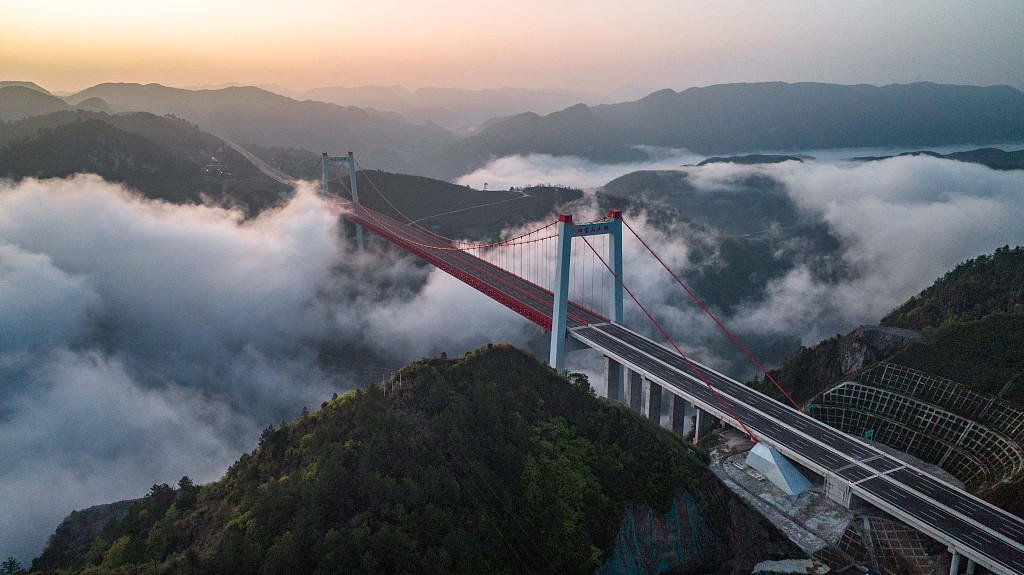China's Mega Bridges that are Shocked by American Engineers
Over the previous 4,000 years, Chinese people have constructed tens of thousands of bridges. The bridges serve as a powerful reminder of Chinese ancient culture and showcase the talent and wisdom of their inhabitants. The Anji Bridge, built in China between the years of 595 and 605, is the oldest bridge still intact and in good condition. The majority of tourists who come to China for sightseeing expect to see some sort of Chinese architecture every day, from temples to pagodas to mausoleums to gardens. Chinese architecture that is distinct from other cultures comes after Chinese bridges.
Ancient Chinese bridges are well known and hold a prominent place in both the East and West's histories of bridge building. The Chinese people have built countless brilliantly constructed and gorgeous bridges throughout history. They have facilitated transportation, enhanced sceneries, and become one of the distinguishing features of ancient Chinese culture by bridging rivers and mountains.
The Chinese built a variety of bridge types, including masonry, suspension, cantilever, and timber bridges. In addition, they employed the stone arch in a variety of shapes, including segmental, horseshoe, elliptical, and semicircular. 961,100 road bridges were built in China in 2021, an increase of 48,300 from the year before. From 658,100 in 2010, China's road bridges have grown by about 46% during the last 12 years. Due to a number of internationally acclaimed bridge projects that have had a large international influence, China is known for its expertise in the field of bridge engineering. More over half of the top 10 bridges worldwide in each category are Chinese bridges.
(01) Chishui River bridge
In Xishui County, Guizhou, China, there is a suspension bridge called the Chishui River bridge. At 323 m, it is among the tallest bridges in the world (1,060 ft). The bridge carries traffic across the Chishui River as a section of the Xugu Expressway. The bridge opened in 2020 after construction started in 2014. The bridge has one of the largest main spans ever built at 1,200 m (3,900 ft). On the Sichuan part of the Xugu expressway, additional high bridges include Shilianghe, Luosizhai, Tiantanghe, Modaoxi, and two Gulin River crossings.
As the Chishui River Bridge design became more complicated, Sichuan Road & Bridge realized they required a more adaptable, digital workflow to guarantee an accurate design, enhance team communication, and prevent errors and conflicts. With the limited usage of heavy equipment and the difficulty in building an access road, this project was among the most difficult they had undertaken throughout the years. The team had to figure out how to build the main bridge deck as a truss off-site and deliver it to the gorge, as well as how to create a system of 158 cables to support the bridge deck, as normal bridge construction techniques couldn't be used because of this. As a result, conventional 2D design techniques were inadequate.
Sichuan Road & Bridge saved a total of CNY 14.3 million by utilizing Bentley modeling programs for every facet of the project. They figured out how to streamline their digital design process, which enabled them to minimize the footprint of the bridge tower foundation by 30% and the quantity of intricate earthworks required in the hilly area. They increased modeling efficiency by 30% and design efficiency by 10% using unified digital design and effective team communications. Prior to construction, digital design also assisted in resolving 114 conflicts. The Chishui River Bridge was finished by Sichuan Road & Bridge in late 2019 after cutting design time by 60 days and construction time by 19 months.
(02) Green Juice River Bridge
The new Lvzhijiang Bridge, which spans a lonely canyon in the heart of Yunnan Province, is the longest and maybe also the most stunning single tower suspension bridge ever constructed, measuring 798 meters over a river valley. The bridge will speed up and ease traffic in the beautiful and isolated province of Yunnan. The bridge, which is supported at both ends by cables and is built in a mountain valley with a V form, looks as though it defies gravity and is recognized as an engineering marvel. It is only held up by one tower on one side. The Chinese road project is now under construction and is thought to be the first single-tower, single-span connecting viaduct in history.
This bridge, which was a three-year project that was completed in 2019, is an important part of the 9,000 km long Yunnan Highway network and the 190 km long Yuchu Expressway. It will significantly cut the travel time between Chuxiong Yi Autonomous Prefecture in Yunnan and nearby Yuxi City. Despite not being well-known travel spots, Chuxiong and Yuxi City each have unique characteristics. The first is well-known for producing tobacco, while the latter is known for having a dinosaur museum. The two locations, which are in the very center of Yunnan province, will be connected to major cities like Kunming and Dali by the new bridge connection.
Another infrastructure project being carried out by China as part of the Belt and Road program is the new Lvzhijiang Bridge. The nation opened a brand-new, high-speed China-Laos Railway in October 2021. The new Lvzhijiang Bridge, which spans the Yangtze River and connects the Chongming neighborhood to bustling Shanghai in about one hour by car, was inaugurated in China on October 31st, 2021, paving the way for quick development. The district alone is 50% larger in surface area than Singapore. The project, which began in 2019, took around three years to complete. It is anticipated to open to traffic in late 2022.
(03) Hong Kong Zhuhai Macau Bridge
The 55-kilometer (34 mi) Hong Kong-Zhuhai-Macau Bridge (HZMB) is a bridge-tunnel system made up of three cable-stayed bridges, one undersea tunnel, and four man-made islands. Both the longest sea crossing and the longest fixed link over open water exist here. The HZMB connects Hong Kong, Macau, and Zhuhai—three significant Chinese cities on the Pearl River Delta—across the Lingding and Jiuzhou waterways. The HZM Bridge cost 127 billion (US$18.8 billion) to construct and was intended to last 120 years. The governments of Hong Kong, Macau, and mainland China all contributed to the projected US$7.56 billion cost of building the Main Bridge.
Initially planned to open to traffic in late 2016, the building was finished on February 6, 2018, and reporters were then given a ride over the bridge. The HZMB was inaugurated by Chinese President Xi Jinping on October 23 and then opened to the public on October 24. For this massive bridge and related work, Arup offered a wide range of services. These include the Hong Kong Link Road tender and construction, the preliminary design for the major bridge over the continental shelf, environmentally friendly reclamation methods for the artificial island created by the Hong Kong Boundary Crossing Facilities (BCF), and more. Additionally, they worked on the preliminary and detailed designs for the Macau Link Road as well as the infrastructure projects for the Macau BCF. These projects included the feasibility study and detailed designs for the Tuen Mun - Chek Lap Kok Link Northern Tunnel and Southern Connection Viaducts.
(04) Yangbaoshan Bridge
The 300-meter-high Yangbaoshan Bridge is the first 6-lane bridge of its kind in the entire world. On a more direct east-west road that links Guiyang with the cities of Longchangzhen, Jiuhouzhen, and Huangping, the steel truss strengthened suspension bridge spans the upper sections of the Qingshui River in the center of Guizhou Province. The deck is around 360 meters above the original river level or 320 meters above a reservoir.
A unique "suspension-bridge-on-stilts," the lowest leg of the 186.5-meter-tall west tower extends 110.7 meters below the deck. Only six other suspension bridges in the world—Sunxihe, Qingshuihe, Honghe Bridge Jianyuan, Dahe, Malinghe Fenglin, and Tiger Leaping Railway—have tower piers that extend more than 100 meters below the deck.
The Yangbaoshan Bridge, which has a length of 1,112 meters, has a span arrangement of 5x40 + 650 + 6x40 meters. The Ganxi arch-beam bridge, which is approximately 3 kilometers to the south on an expressway spur connecting to the G75 highway, is equally magnificent. The stunning red Wumeihe arch bridge, which has a span of 300 meters and a purported height of 223 meters, is also on the road 50 kilometers to the east.
The Guiyang Expressway Yangbaoshan Extraordinary Bridge, which was successfully closed on March 21, 2021, was reportedly designed by the China Communications No. 1 Public Administration and built by the China Communications No. 2 Public Administration. The project's key technological achievement is the installation of the main cable by aerial spinning, a first for China. The primary cable is 1113 meters long and has four back cables in addition to 72 through-length strands. It weighs close to 4,600 tons and is made up of 24,128 high-strength galvanized steel wires. The aerial spinning method, which differs from the traditional prefabricated parallel cable strand production procedure, uses traction equipment to reciprocate and draw high-strength galvanized steel wire to create parallel steel wire strands on-site. The effective implementation of this technology not only closes the technological deficit in the country, but also serves as a benchmark for the industry as it develops technical standards for the primary way of spinning cable aerials.







.jpg)




Comments